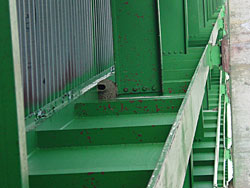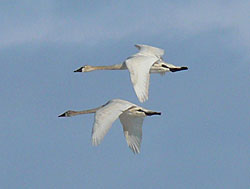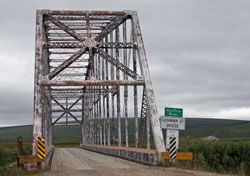Kougarok Road
Mile 58–67 Golden Gate Pass to Kuzitrin River Bridge
This section of the Kougarok Road crosses broad flat river valleys with wide floodplains that are unique to the interior portion of the Seward Peninsula. The lowlands with poor drainage have thermokarst features in the form of pingos and polygons that develop when ice layers force their way to the surface of the soil. After crossing the Kuzitrin River valley, the road enters the interior uplands, characterized by broad rounded hills with sparse vegetation and deep rounded valleys with vast expanses of tussock tundra habitat. The summer climate can be hot enough to generate thunder storms and lightning strikes from these localized storms may commonly start tundra fires in this area. Some summer days have hazy skies due to tundra fires burning in the distance. The fires create ash that fertilizes the thin layer of soil and produces lush white areas cotton grass during the blooming period of late June.
Mile 58 — Possible raptor viewing
Habitats types: Rocky outcrops, river valley
Use binoculars to scan the rock cliff directly across the river from a large camp for a pair of nesting rough-legged hawks.
Mile 60.3 — Pilgrim River Bridge
Habitat: River valley

The Pilgrim River crossing brings you close to the groves of cottonwood, also known as balsam poplar, that are abundant in this section of the valley. The presence of warmer soil associated with ground water springs in this portion of the valley contributes to the growth of deciduous trees. A lower understory of tall dense willow and alder attract birds that are similar to those found at Pilgrim Hot Srpings and often associated with boreal habitats. This area has great horned owl, alder flycatcher, varied thrush, yellow-rumped warbler, and blackpoll warbler. In the flood zone near the bridge there are numerous beaver dams that block the side sloughs and make ponds used by a variety of water birds. The bridge railing is used as a perching area by Arctic tern and gulls when they rest between feeding flights above the river.
Notable Wildlife
- Cliff Swallow build mud nests under the bridge.
- Arctic tern perch on the bridge before plunging into the water after small fish.
- Blackpoll warbler in tall vegetation at north end of the bridge.
- Moose depend on the Pilgrim River for critical winter habitat. While moose typically disperse to willow-covered tributaries and side slopes in summer, cows and calves may remain along the main river in summer to feed on nutritious new shoots that spring from the constantly shifting gravel bars and shoreline.
- Red salmon and a few king salmon pass under the bridge on their way to Salmon Lake to spawn in July and August.
- Chum, silver, and pink salmon spawn between the bridge and Pilgrim Hot Springs.
- Whitefish schools sometimes swim in the area close to freeze-up.
- Burbot and Northern pike swim in the Pilgrim River.
Mile 61 — Pilgrim River Overlook
Habitat: Ponds, tundra meadow, river valley

Notable Wildlife
- Tundra swan, glaucous gull, Canada geese, American wigeon and red-necked grebe frequent the ponds and meadows.
- Sandhill crane give a loud, trumpeting call that can be heard from a distance.
- Muskoxen sometimes feed in the grassy meadows at the base of Hen and Chickens Hill in summer and spend the winter on the summit.
- Moose frequent the area.
Mile 64–65 Swan Lake
Habitat: Ponds, tundra meadow
The second of these two lakes is named Swan Lake but both may hold similar birds.
Notable Wildlife
- Tundra swan with cygnets, Canada geese, sandhill crane, northern shoveler, black scoter, greater and lesser scaup, and canvasback frequent the ponds and meadows.
- Red-necked grebe build floating nest platforms.
- Muskrat may be present in some years.
Mile 67.5 — Kuzitrin River Bridge

Habitat: River drainage, ponds, human-modified
Native history
Farther upriver at the confluence with the Kougarok River are the remains of sod houses. Local Inupiat once used the camp to catch and preserve whitefish, prized for its flavorful meat and high oil content.
Gold Rush History
The Seward Peninsula Railway ended upriver from the bridge. The terminus was originally at the town of Shelton, but after ice repeatedly destroyed the bridge, the company moved it to Bunker Hill where a ferry carried people and equipment across the Kuzitrin River. A road on the other side led to Taylor and other gold mining areas.
History of the bridge
The Kuzitrin Bridge was originally named the Cushman Street Bridge and was built in 1917 to span the Chena River in the heart of downtown Fairbanks. The bridge was disassembled in the late 1950s, to be replaced by a concrete span, and shipped down the Chena, Tanana and Yukon Rivers where it was then barged up the Bering Sea Coast to Nome. Workers hauled the sections up the Nome-Taylor Highway and reassembled the bridge in its current location in 1958.
Notable Wildlife
- Cliff swallow typically built gourd-shaped mud nests under the bridge, tree swallow nest in the nearby cottonwoods, and bank swallow nest in mud cut banks along the river’s edge
- Say’s phoebe often seen close to the small cabins near the bridge.
- Rusty blackbird in the tall vegetation that flanks the river bank.
- Moose depend on the Kuzitrin drainage for winter habitat.
- Huge runs of broad whitefish may be visible from the bridge shortly before freeze-up in October. Some local people still seine or set nets through the ice for these fish
- Northern pike and burbot are found in the Kuzitrin and feed upon whitefish.
- Many gulls and common raven stay in the area well into October to feed on the whitefish.
